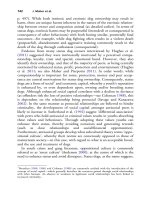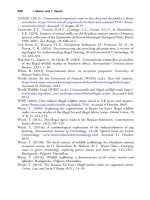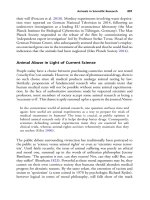The palgrave international handbook of a 141
Bạn đang xem bản rút gọn của tài liệu. Xem và tải ngay bản đầy đủ của tài liệu tại đây (29.12 KB, 1 trang )
132
J. Maher et al.
natural characteristics and behaviours. These dogs are harmed by an increase in
breeding deformities, inherited disorders and behavioural abnormalities, being
forced to live an unnatural existence, and the needless destruction of countless
lives (due to over-breeding and/or a decline in popularity). Central to the harms
experienced by these dogs is the fact that they are replaceable. Their value is
linked to external, often changing factors.
Recent use in the UK of the term ‘status dogs’ has specifically referred to a
trend amongst young people to own types of bull, illegal or other perceived to
be aggressive breeds of dog. These dogs are used to confer an image of
toughness, an air of aggression, and their use as an extension of UK youth
gang violence (for example as weapons and in turf wars) has been documented
(Harding 2012; Hughes et al. 2011). However, by treating these dogs as a
commodity, status symbol, bodyguard or weapon, their owners subject them
to behaviour frequently resulting in the torture and death of the dog and
occasionally the injury and even death of a person. Additionally, the contributing factors to dog attacks—according to the experts—namely the history
and temperament of the dog and the circumstances of how it is kept, including
the welfare standards and type of training it is subjected to, appear irrelevant in
media reports. Conversely, aggression is deemed to be entirely a derivative of
breed—a conclusion that is thoroughly at odds with the findings of the
scientific community (Newman 20122). A US study (Duffy et al. 2008) of
6,000 dogs and their owners found that the most aggressive breed—that is, the
dog most likely to bite strangers and their owners—was the Dachshund (the
pit bull was eight on this list). In light of this it is encouraging to see in more
recent times some evidence that dog owners are more aware that any dog is
potentially dangerous (Oxley and Cheng 2014). Given the high levels of
irresponsible dog ownership in the UK, as evidenced in Royal Society for
the Prevention of Cruelty to Animals [RSPCA] and police statistics surrounding cruelty and dangerous dogs (see below), in addition to the high numbers of
stray dogs (see below) and dog fouling (Keep Britain Tidy n/d), the connection
between the way in which dogs are treated and the potential for this—albeit
very rarely—to result in dog aggression, may not be widely understood.
However, because of the implied risk to people, the official response further
victimises these breeds and has unhelpfully placed other controversial labels
onto them (for example, ‘devil dogs’).
2
See also ongoing research which aims to evaluate this issue further: www.liverpool.ac.uk/dog-aggres
sion/about-the-project/









